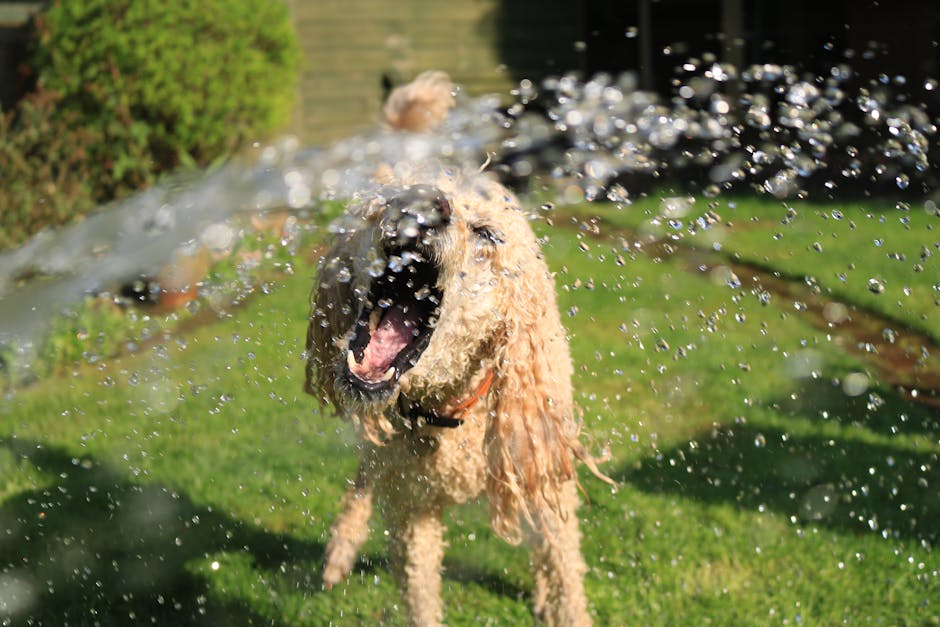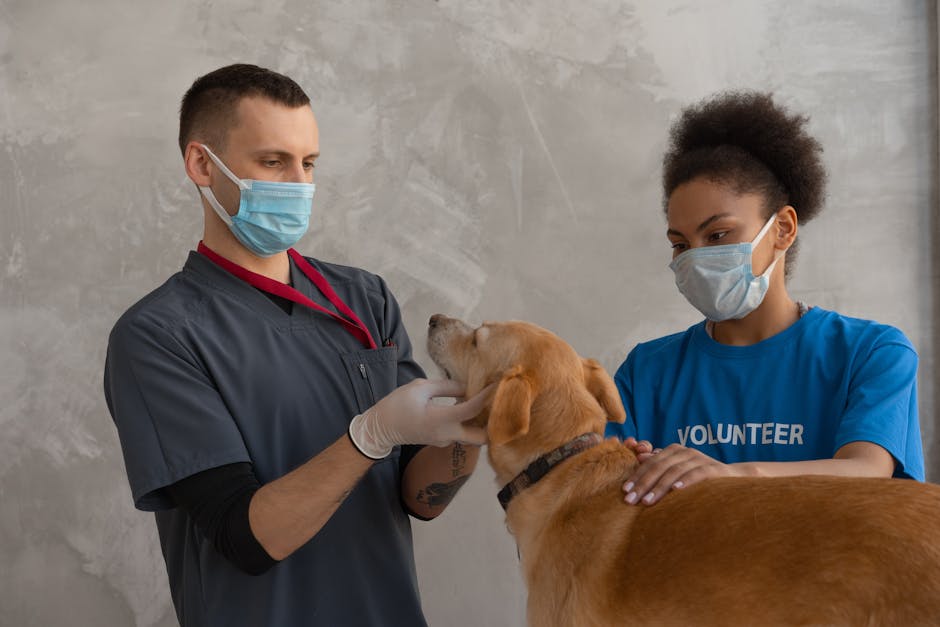Cleaning your dogs ears
Posted by Derek Lambert on 26th May 2023
If you are a dog owner, you might have noticed that your furry friend's ears get dirty easily. Whether it's because of their floppy ears, allergies, or ear infections, dogs require regular ear cleaning to avoid any health complications. Ear cleaning is an important part of your dog's hygiene routine, and it should be done carefully and regularly to prevent any damage to their delicate ear canals. In this blog post, we will provide you with all the information you need to know about dog ear cleaning, including when to clean your dog's ears, the tools you need, and how to clean them properly.
Types of ear infections and their symptoms (otitis externa, yeast infections, etc.)

Ear infections in dogs can be caused by a number of different factors, such as allergies, foreign objects, or parasites. There are several different types of ear infections that can affect dogs, each with their own specific set of symptoms.
Otitis externa is a common type of ear infection in dogs, which affects the outer ear canal. Symptoms often include redness or swelling of the ear, as well as discharge or a foul odor coming from the ear. Dogs may also shake their head or scratch at their ears in an attempt to relieve the discomfort.
Yeast infections are another type of ear infection commonly seen in dogs. This occurs when there is an overgrowth of yeast within the ear canal. Symptoms may include a brown or yellow discharge, as well as a foul odor and itching or redness of the ear.
Bacterial infections can also affect the ears of dogs, causing symptoms such as inflammation, discharge, and foul odor. Other types of ear infections may be caused by ear mites or other parasites, leading to itching and irritation within the ear canal.
It is important to identify the type of ear infection your dog may be experiencing in order to properly treat it. Talk to your veterinarian if you notice any of these symptoms in your dog's ears.
Cleaning supplies needed (ear cleaner solution, cotton balls/pads, gloves)

When it comes to cleaning your dog's ears, having the right supplies is important. You'll need an ear cleaner solution that is specifically formulated for dogs, as using a human ear cleaner can be harmful to their delicate ears. You'll also need cotton balls or pads to help wipe away any debris or excess solution. It's important to wear gloves to protect your hands and to prevent the spread of any potential infections. Having these supplies on hand before beginning the ear cleaning process can make the experience smoother and safer for both you and your furry friend.
How to prepare your dog for ear cleaning (positive reinforcement, making them comfortable)

Photo by Goochie Poochie Grooming on Pexels
Before starting with the ear cleaning process, it's crucial to prepare your furry friend to make them feel comfortable and at ease. However, you must always remember to offer positive reinforcement to your dog during this process. Begin by spending time with your dog and petting them gently on the ears, neck, and head, to get them accustomed to you touching those particular parts of their body. You can also give them a treat to make the experience more positive. If your dog has had a bad experience with ear cleaning in the past, introduce the tools slowly and gradually, allowing them to sniff them out first. As you move along, talk to your dog in a calm and soothing way, and keep reassuring them with gentle touches and treats. This way, your dog will have a better chance of cooperating and being more accepting of the ear cleaning process.
Step-by-step instructions for ear cleaning (inserting solution, massaging the ear, wiping away discharge)

Begin by gathering the necessary supplies. You will need a commercial ear-cleaning solution, cotton balls, and a towel. Make sure the ear-cleaning solution is appropriate for your dog's breed and size, and read the instructions carefully before use.
Next, gently hold your dog's head and lift the ear flap to expose the ear canal. Insert the recommended amount of ear-cleaning solution, taking care not to puncture the eardrum. Massaging the base of the ear for a few seconds helps to spread the solution inside.
Then, release your dog and let them shake their head. This allows the solution to break up any debris or wax buildup inside the ear canal.
Use cotton balls to wipe away any excess ear-cleaning solution from the ear flap and surrounding area. You can also use cotton swabs, but only on the visible outer part of the ear, as inserting them too far into the ear canal can cause damage.
Finally, use a towel to gently wipe any discharge or excess solution away from the area. Repeat on the other ear if necessary.
Regular ear cleaning can help prevent ear infections and keep your dog's ears healthy and comfortable. If you notice excessive discharge or a foul odor, consult your veterinarian, as it may indicate an underlying issue.
How often to clean your dog's ears (depending on breed and lifestyle)

Cleaning your dog's ears is an important part of their overall hygiene routine. However, knowing how often to clean your dog's ears can be a bit tricky as it depends on several factors including their breed, lifestyle, and health condition. Some dogs produce more ear wax than others or have floppy ears that trap moisture and dirt, making them more prone to ear infections. Here's a general guideline for how often you should clean your dog's ears:
- Breeds with floppy ears, such as Cocker Spaniels, Basset Hounds, and Bloodhounds, may require more frequent cleaning, at least once a week. - Breeds with upright ears like Chihuahuas or Jack Russell Terriers may need less frequent cleaning, around once a month. - Dogs who spend a lot of time swimming or playing in the water, especially in dirty or polluted areas, may require more frequent ear cleaning to prevent infection. - If your dog is prone to ear infections, your vet may recommend cleaning their ears more frequently as part of their treatment plan.
Remember, each dog is unique, so it's important to observe your dog's behavior and health condition, and consult with your vet about the best ear cleaning routine for your furry friend.
Tips for maintaining ear health (regular grooming, avoiding water in ears)

Photo by Jack Geoghegan on Pexels
Photo by Till Daling on Pexels
Maintaining your dog's ear health is essential to prevent infections and discomfort. Regular grooming and cleaning of the ears can help keep them clean and healthy. Here are some tips for maintaining good ear health:
1. Check your dog's ears regularly: Look for signs of ear irritation, discharge, or inflammation. Catching an ear problem early can prevent it from turning into a bigger issue.
2. Groom your dog's ears: Regular grooming like brushing or combing can help prevent mats, tangles and debris from collecting in the ears. This can also help with air circulation which discourages infections.
3. Avoid water in ears: Dogs can be prone to ear infections if water is trapped in their ears after swimming or bathing. Be sure to dry your dog's ears thoroughly with a towel.
4. Remove hair from the ear canal: Dogs with hairy ears are more likely to develop ear infections due to the buildup of wax and moisture. Ask your vet or groomer to show you how to safely remove hair from the ear canal.
By following these simple tips, you can help keep your dog's ears healthy and clean. Remember to always consult with your veterinarian if you notice any abnormal signs in your dog's ear health.
Warning signs that your dog may have an ear infection (foul odor, excessive scratching/shaking, discharge)

Photo by @rrinna on Pexels
.
If you notice that your dog is persistently scratching or shaking its head, or you detect a foul odor emanating from its ears, it could be a sign that your pet has an ear infection. Other symptoms to watch out for include discharge from the ears, swelling, redness, and changes in your dog's behavior such as loss of balance or sensitivity around the ear area. In some cases, dogs may also develop fever, lethargy and loss of appetite, which may be indicative of a severe ear infection that requires urgent medical attention. As a responsible pet owner, it is important to monitor your dog's ear health regularly and seek veterinary advice if you notice any warning signs of an infection.
When to seek veterinary treatment for your dog's ear infection (if symptoms persist or worsen)

Photo by Mikhail Nilov on Pexels
If you've noticed that your dog's ear infection symptoms have persisted or worsened over time, it's certainly time to seek professional veterinary treatment. While some mild cases of ear infections can be treated with home remedies, more severe infections require the help of a trained veterinarian to prevent the infection from becoming a chronic condition.
If your dog's ear infection symptoms recur frequently, it's a good idea to discuss potential underlying causes with your veterinarian. Your vet can perform tests to determine whether your dog is suffering from an underlying condition such as allergies, dermatitis, or hormonal imbalances. Once the root cause of your dog's ear infection is identified, your veterinarian can develop a comprehensive plan to treat both the underlying issue and the ear infection itself.
Remember that seeking veterinary help early is the most effective way to prevent a mild ear infection from becoming a chronic, painful, and expensive condition. If you notice any changes in your dog's behavior or physical symptoms, it's important to consult with an experienced veterinarian as soon as possible.
